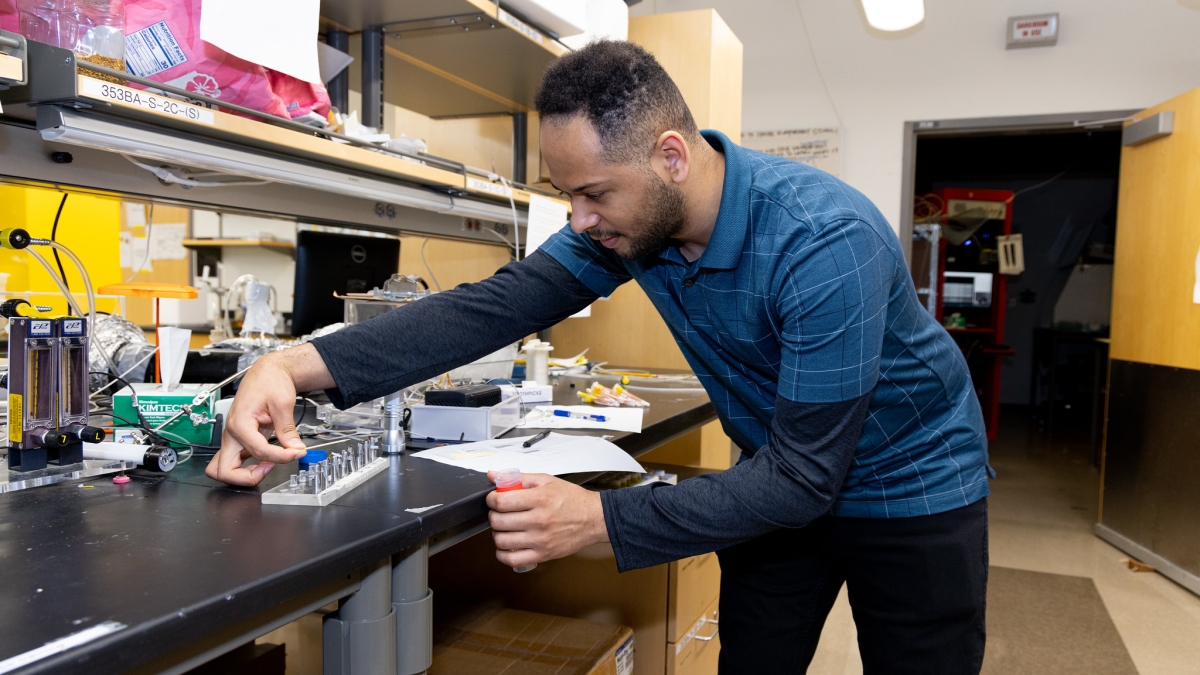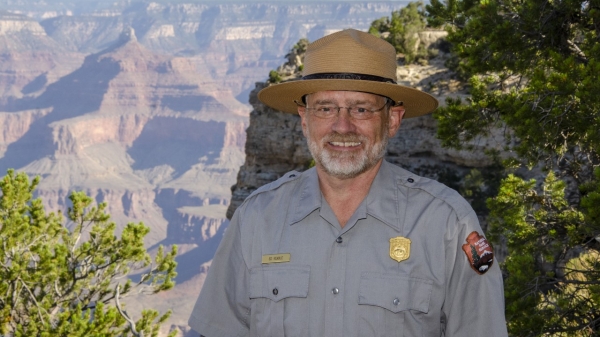1st OURS symposium recognizes research projects from ASU Online students

ASU student Jamal Bell working in a lab on his research project. Photo by Meghan Finnerty
The Online Undergraduate Research Scholars (OURS) Symposium on April 14 gave online undergraduate students at The College of Liberal Arts and Sciences an opportunity to present their research in a virtual environment.
Students, faculty, friends and family in attendance roamed through four separate virtual rooms to see student projects in the virtual Gather.town workspace. In the rooms, attendees could observe the different presentations and ask students questions about their findings.
The inaugural virtual symposium for online student research is one of the ways Arizona State University and The College are helping bridge the gap between online and in-person learning experiences.
Faculty also took time during the event to discuss the growth of online learning and the importance of continuing to put effort and resources into online education.
“We are thrilled to have offered this opportunity to the online students who have done a fantastic job this year engaging in research,” said Ara Austin, senior director of online engagement and strategic initiatives at the college. “We are also grateful for the hundreds of faculty, staff and fellow student attendees who came to the symposium to listen and support the student presenters.”
There were plenty of things to explore during the symposium, with projects covering various topics within the humanities, natural sciences and social sciences disciplines.
In the Online Turkey Team Education and Research experience through the School of Life Sciences, online students Priscilla Hanson, Britt Kitchens and Francisco Miranda investigated the role of turkey head color change in communication.
Marissa Martinez, an online English student, researched the portrayal and role of women in John Steinbeck’s novels “A Russian Journal” and “The Grapes of Wrath.”
In another research project on animal behavior, biological sciences student Mariana Bustamante observed the productivity levels of honeybees in maintaining the colony’s preservation.
She researched the role of the undertakers, who are responsible for removing the dead and diseased bees from the hive to help keep the colony safe.
“I observed the undertakers' behavior of grabbing a dead or diseased bee toward the exit of the hive,” Bustamante said. “I found when the hive was cooler, the lower the activity, but when temperatures warmed, the more active and efficient they were.”
Her remote research used a three-camera setup recording 4K video footage from a live beehive containing 14,000 honeybees at ASU’s Bee Lab Annex.
Other projects presented during the symposium focused on cancer education, political polarization, astrophysics and biology.
For a complete list and abstract of the 23 projects, visit the OURS Symposium webpage.
Creating accessible learning
During the panel discussion at the symposium, faculty members discussed the growth of online education over the years and its role in fulfilling ASU’s mission of creating accessible learning opportunities for all.
Success at ASU is measured “not by whom it excludes, but by whom it includes and how they succeed,” according to the university’s charter.
In alignment with that, the university created a digital learning space with the notion of inclusion, social embeddedness and empowering the success of every student.
“It provides opportunities for working professionals, parents, grandparents,” said School of Geographical Sciences and Urban Planning Professor Ronald Dorn. “It allows those people to have the same opportunities as every other student.”
“The idea that someone should be required to come to a class at a certain day, certain time, in a certain place in person or you weren’t allowed to attend class is not right,” said Ian Gould, associate dean of online strategies and initiatives and President’s Professor. “Offering educational opportunities to everyone aligns with our charter and mission.”
Online learning at ASU refuses to limit what students can learn. In fact, faculty see it as a way to bring even more classes, research opportunities and interactive learning experiences directly to the digital landscape for students.
“Online crystalizes thinking,” said the School of Historical, Philosophical and Religious Studies Professor Catherine O’Donnell. “You can go to any museum in a digital sense. If things can be digital, there are far more opportunities to engage with those things.”
Online learning also presents challenges, most notably connecting with students and helping them succeed in a digital landscape.
The panel addressed these struggles and provided advice to help overcome them.
“Make those connections with the students,” O’Donnell said. “Figure out how to put students in a community with each other and make it clear that you (the teacher) are alive and ready to engage with them.”
More Arts, humanities and education

Grand Canyon National Park superintendent visits ASU, shares about efforts to welcome Indigenous voices back into the park
There are 11 tribes who have historic connections to the land and resources in the Grand Canyon National Park. Sadly, when the…
ASU film professor part of 'Cyberpunk' exhibit at Academy Museum in LA
Arizona State University filmmaker Alex Rivera sees cyberpunk as a perfect vehicle to represent the Latino experience.Cyberpunk…

Honoring innovative practices, impact in the field of American Indian studies
American Indian Studies at Arizona State University will host a panel event to celebrate the release of “From the Skin,” a…